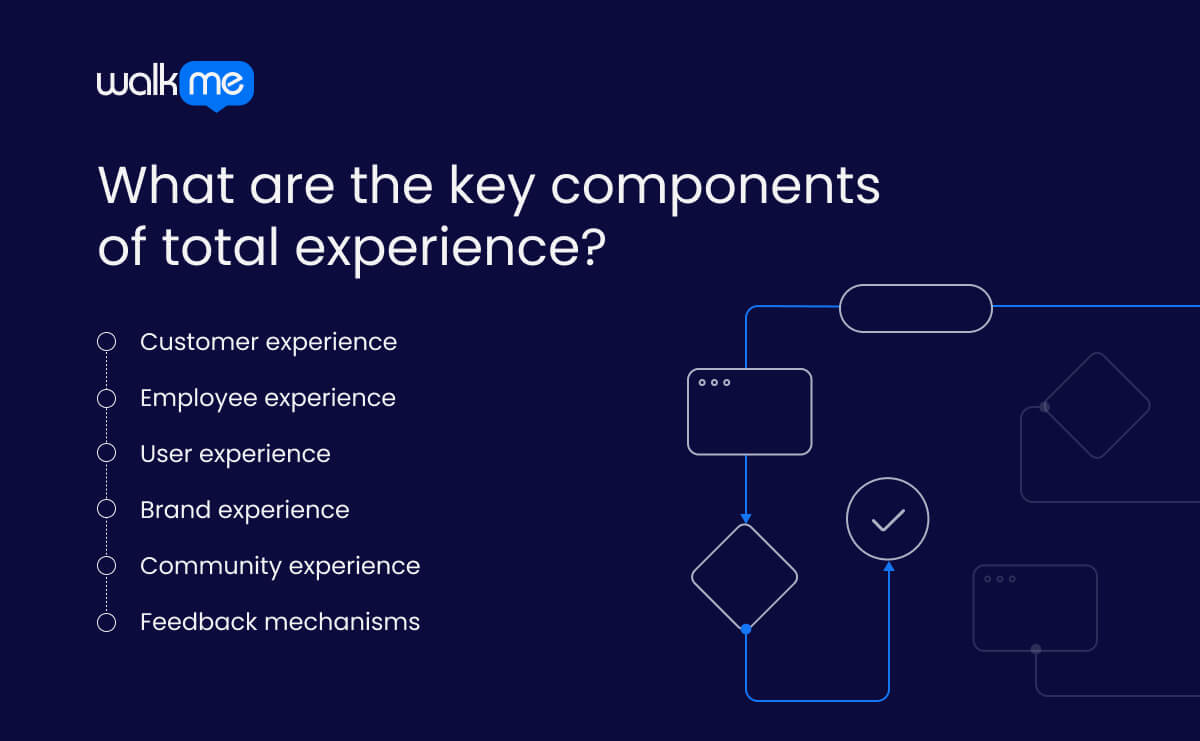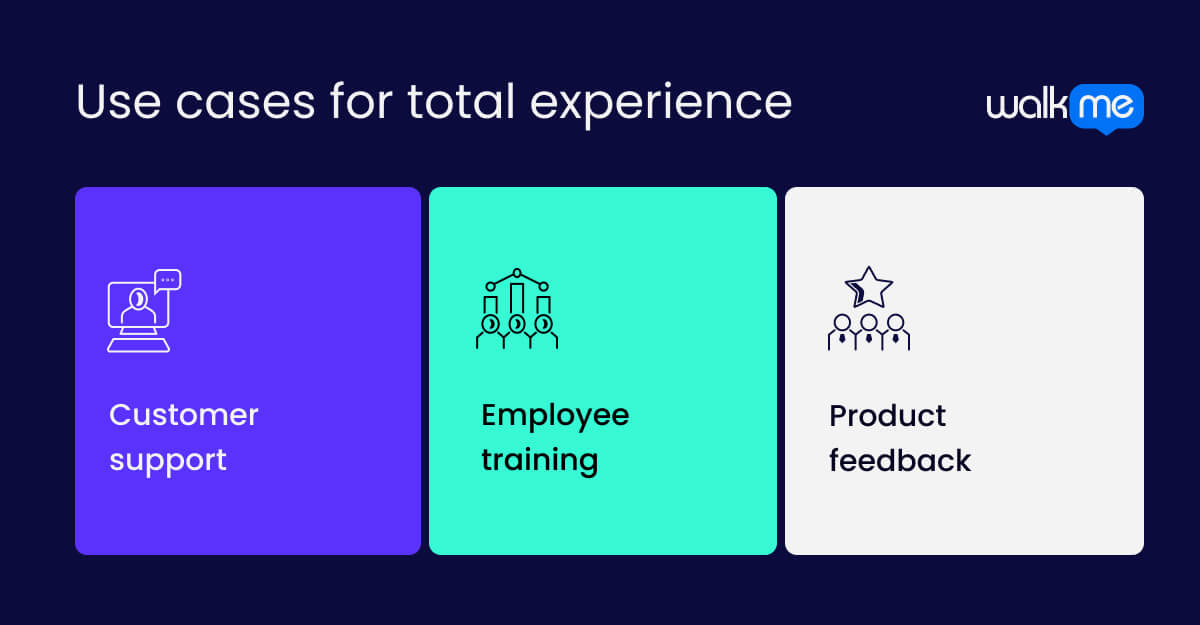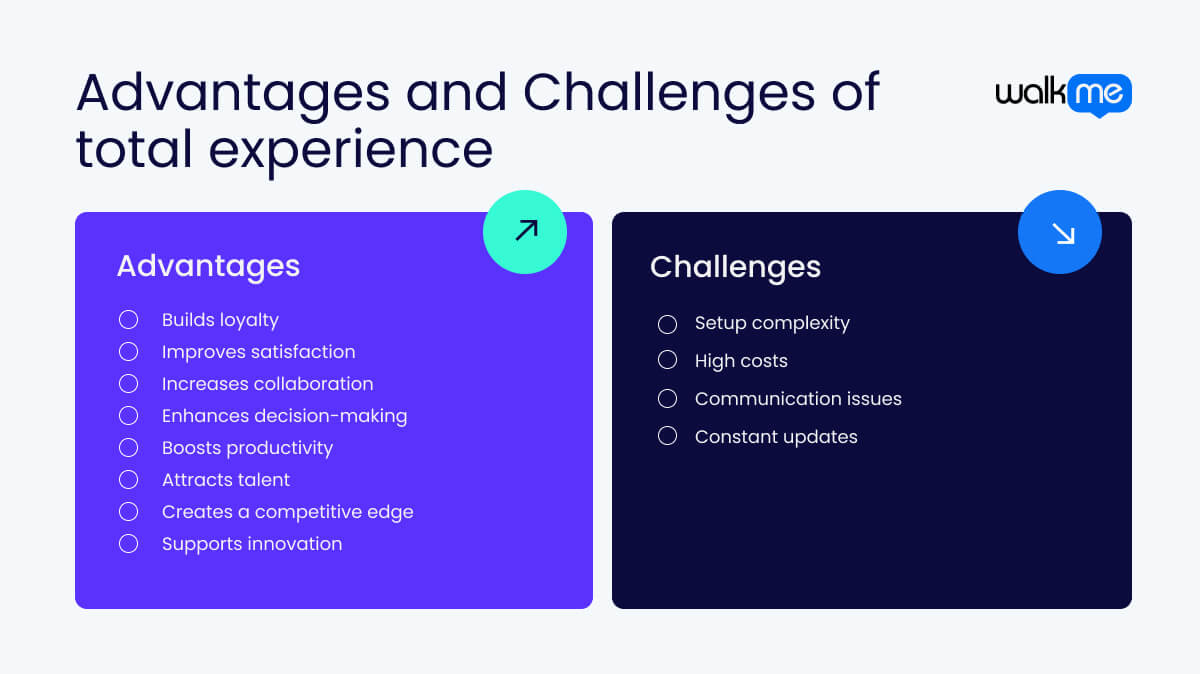What is total experience?
Total experience (TX) is a way for businesses to understand how they connect with everyone, like customers and workers. It combines how customers feel (customer experience), how workers feel (employee experience), and how people use their products (user experience) to make everything work well together.

Table of contents
Total experience also means using technology and information to improve processes. Businesses can ask people what they like and use that information to learn. As a result, they can make better choices and keep improving how everyone feels over time.
The area is rapidly developing. For example, Gartner reveals that total experience technology helps improve the experiences of customers, employees, and users all at once.
New technologies like 6G, digital twins of customers, and spatial computing make it easier to connect, personalize interactions, and create more engaging experiences. This helps businesses make things better for everyone involved.
What are the key components of total experience?

Knowing the key components of total experience helps us understand how businesses can make everyone feel good. These parts work together to create a positive experience for customers, employees, and users.
Let’s explore the important components that make the total experience effective and enjoyable for everyone involved.
Customer experience
How customers feel when they interact with a business. It includes everything from the first time they hear about the company to when they buy something and even after their purchase. When customers have a good experience, they are more likely to be happy and come back for more. A positive customer experience makes them feel valued and appreciated.
Employee experience
How workers feel about their jobs and the company they work for. Happy employees are usually more motivated and excited to help customers. When workers feel supported and enjoy their work environment, they can provide better service. Customers feel good too, so it creates a positive cycle where everyone benefits.
User experience
How easy and enjoyable it is for people to use a product or service. For example, if someone visits a website, they should be able to find what they need without any trouble. A good user experience means that people can navigate websites, apps, or products easily and without getting frustrated. When users have a great experience, they are more likely to tell others about it.
Brand experience
How customers see and connect with a brand. It includes the company’s values, messages, and overall image. A strong brand experience helps build trust and loyalty. When customers feel that a brand shares their values and treats them well, they are more likely to stick with that brand over time.
Community experience
How businesses interact with their community, including customers, employees, and other important people. A strong sense of community makes everyone feel included and valued. When businesses engage positively with their community, it can create loyalty and trust, which are essential for long-term success.
Feedback mechanisms
Systems that help businesses gather opinions and thoughts from customers and employees. Regularly asking for feedback helps companies understand what people like and what could be improved. When businesses listen to this feedback, they can make changes that improve everyone’s experience over time.
Total experience vs. customer experience vs. employee experience vs. user experience
Total experience, customer experience, employee experience, and user experience all focus on feelings and interactions, but they each look at different groups.
- Total experience looks at everyone involved, including customers, employees, and users, to create a complete picture
- Customer experience focuses only on how customers feel about a brand
- Employee experience is about how workers feel in their jobs
- User experience centers on how easy and enjoyable it is for people to use a product
Let’s explore the differences between these four terms.
| Total experience | Customer experience | Employee experience | User experience | |
| Definition | How customers, employees, and users feel about a brand or company. It looks at how all these experiences work together. | How customers feel after interacting with a brand during their buying journey. | How workers feel about their jobs and the company. | How users feel when they use a product or service, especially how easy it is to use. |
| Focus | Everyone involved, including customers, employees, and users. The goal is to connect their experiences for a better outcome. | Only on customers and how they interact with the brand, from when they first hear about it to after they buy something. | Employees and their feelings about their work, the company culture, and the support they get. | Users and their interactions with specific products, like websites, apps, or gadgets. |
| Techniques | Asking for feedback from all groups, looking at how they interact with the company, and using data to make improvements. It often requires teamwork across different departments. | Asking customers for their opinions, mapping their journey, and personalizing marketing. Companies use data to understand customer preferences. | Asking employees for feedback, holding performance reviews, and doing team-building activities. Companies often provide training to help workers grow. | Testing how easy a product is to use, asking users what they think, and designing user-friendly interfaces. Designers create prototypes and test them to make improvements. |
| Goals | To make everyone happy and loyal to the company, which helps the business do better. It wants to create a smooth experience for all. | Make customers happy, so they come back to buy more. Companies want to create positive experiences. | Make employees engaged and happy, which leads to better work and happier customers. | Make products that are easy to use and enjoyable for users, which keeps them coming back. |
| Examples of use | A company might gather ideas from both customers and employees to improve products and services. For example, a store might change its layout based on what customers like and what employees suggest. | A business might change its website to make it easier for customers to find what they want and buy it quickly. | A company might hold regular meetings to hear from employees and offer training programs to make sure they feel valued and supported. | A software company might watch users try out a program to see where they get stuck, then change the design to make it easier to navigate. |
Use cases for total experience

Total experience happens in many different business situations.
It helps with things like making customer support better, improving employee training, and collecting feedback about products.
Gartner says that In healthcare, a total experience approach can improve remote patient monitoring by making it easier for patients to share clinical data and for clinicians to access the insights they need. Such an approach helps keep patients engaged and reduces burnout for clinicians, creating a smoother experience for everyone.
Knowing how total experience works can be hard to understand, so here are three further examples to explain it more clearly.
Customer support
Good customer support helps customers feel valued and cared for. When a customer has a question or problem, they can reach out in different ways, like phone, email, or chat. The support team is trained to help quickly and effectively. Providing assistance in this way makes customers feel heard and helps them find solutions quickly. With good support, customers are happier and more likely to return, which is great for the business.
Employee training
Strong employee training helps workers do their jobs well and feel confident. When a new employee starts, they go through training that teaches them about the company and their role. The training is designed to be engaging and helpful, using different methods like videos and hands-on activities. Feeling prepared helps employees provide better service to customers. The overall experience becomes better for everyone involved.
Product feedback
Collecting product feedback helps businesses understand what customers think about their products. After someone buys a product, the company may send a simple survey to ask how satisfied they are. Customers can share what they like and what they think could be better. Improvements based on this feedback help the company make changes. When businesses listen to their customers, it shows they care and want to make things better, which can lead to happier customers and better products.

What are the advantages of total experience?
Total experience has many benefits for a business. When a company cares about how customers, employees, and users feel, it can improve everyone’s experience.
Let’s look at all the ways total experience can help a business do well and grow.
Builds loyalty
Total experience helps create a stronger connection between customers, employees, and users. When everyone feels valued and respected, they are more likely to stay loyal to the brand. A loyal customer is someone who keeps coming back to buy more, which is great for the company’s success and growth over time.
Improves satisfaction
Focusing on everyone’s feelings means total experience works to make both customers and employees happier. When people feel good about their interactions with the brand, they are more likely to tell others about their positive experiences. Happy customers can lead to new customers, which helps the business grow.
Increases collaboration
Total experience encourages different departments to work together. When teams share their feedback and ideas, they can solve problems more effectively and come up with new and better ways to do things. Teamwork leads to a smoother workflow and helps the company become more efficient.
Enhances decision-making
Leaders can make better choices by using data from all experiences. Understanding how customers and employees feel helps them see what needs improvement. When decisions are based on real needs and opinions, the company can make changes that truly benefit everyone involved.
Boosts productivity
Engaged and happy employees tend to work better. A positive work environment created by total experience leads to higher productivity, meaning employees can accomplish more in less time. In turn, this helps the company achieve better results and reach its goals.
Attracts talent
Companies that focus on total experience become more attractive to job seekers. A good reputation for taking care of both customers and employees makes people want to work there. Skilled workers are more likely to apply to companies that they see as successful and supportive.
Creates a competitive edge
Providing a great total experience helps a company stand out from its competitors. When customers and employees feel satisfied, they are more likely to choose that brand over others. Such an advantage can lead to more business and a stronger position in the market.
Supports innovation
Total experience encourages everyone to share their thoughts and ideas, which leads to new inventions and improvements. When employees and customers feel comfortable providing feedback, the company can find creative solutions and make changes that benefit everyone.
What are the challenges of total experience?
Let’s look at the challenges of building a good total experience. Total experience tries to improve things for customers, employees, and users. But some problems can make this hard to do. It’s helpful for businesses to know these challenges so they can be ready to handle them.
Setup complexity
Setting up total experience can be complicated. It involves connecting different parts of the business, like customer service, employee support, and product design. Getting everyone on the same page and using the same tools can take a lot of time and planning.
High costs
Building a strong total experience program can be expensive. It may require special tools, extra staff, or training. Companies need to make sure they have the budget and resources to support it fully, which can be a big investment.
Communication issues
Total experience relies on good communication between departments. Sometimes, teams don’t share information well, which can lead to misunderstandings. Without clear communication, it’s harder to create a smooth experience for customers and employees.
Constant updates
To stay effective, total experience requires regular updates. As customer needs and technologies change, the company has to adjust its approach. In other words, it must always be looking for new ideas and ways to improve, which takes time and ongoing effort.